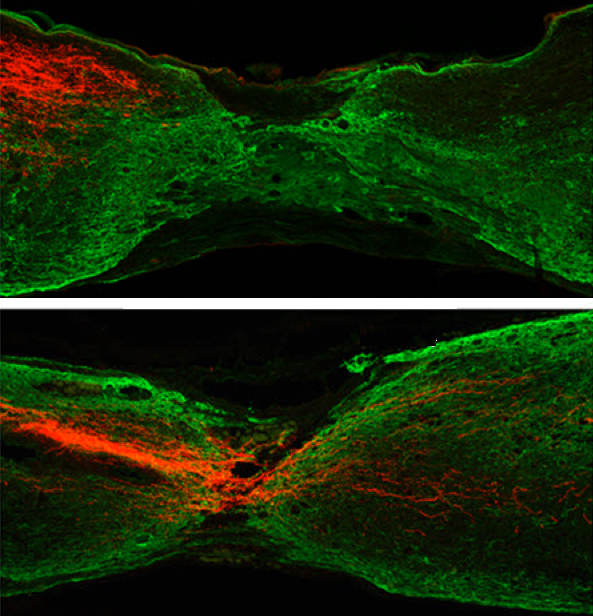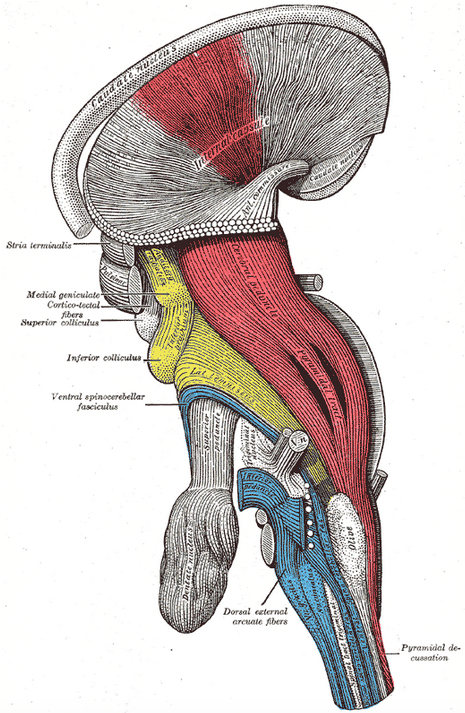How to regenerate axons to recover from spinal-cord injury
July 17, 2015

HKUST researchers cut mouse corticospinal tract axons (labeled red). A year later, they deleted the Pten gene in the experimental group (bottom) but not the control group. The Pten gene removal resulted in axon regrowth in seven months, unlike the control group (top). (credit: Kaimeng Du et al./The Journal of Neuroscience)
Researchers at the Hong Kong University of Science and Technology (HKUST) have found a way to help patients recover from chronic spinal cord injury (SCI) by stimulating the growth of axons.
Chronic SCI prevents a large number of injured axons from crossing a lesion, particularly in the corticospinal tract (CST). Patients inflicted with SCI often suffer a temporary or permanent loss of mobility and paralysis.
As reported in the July 1st issue of The Journal of Neuroscience, the researchers found that deleting the PTEN gene in mice neurons results in stimulation of growth of axons across the lesion (wound) and past it —- even when treatment was delayed up to 1 year after the original injury.
The deletion also up-regulated (increased) the activity of another gene called MTOR (the mammalian target of rapamycin), which further promoted regeneration of the axons.

Corticospinal tract (credit: Gray’s Anatomy/Wikimedia Commons)
“As one of the long descending tracts controlling voluntary movement, the corticospinal tract (CST) plays an important role for functional recovery after spinal cord injury,” says Kai Liu, PhD, the study’s senior author and assistant professor in life sciences at HKUST.
“The regeneration of CST has been a major challenge in the field, especially after chronic injuries. Here we developed a strategy to modulate PTEN/mTOR signaling in adult corticospinal motor neurons in the post-injury paradigm.
“It not only promoted the sprouting of uninjured CST axons, but also enabled the regeneration of injured axons past the lesion in a mouse model of spinal cord injury, The results considerably extend the window of opportunity for regenerating CST axons severed in spinal cord injuries.
“It is interesting to find that chronically injured neurons retain the ability to reform tentative synaptic connections,” says Liu. “PTEN inhibition can be targeted on particular neurons, which means that we can apply the procedure specifically on the region of interest as we continue our research.”
Abstract of Pten Deletion Promotes Regrowth of Corticospinal Tract Axons 1 Year after Spinal Cord Injury
Chronic spinal cord injury (SCI) is a formidable hurdle that prevents a large number of injured axons from crossing the lesion, particularly the corticospinal tract (CST). This study shows that Pten deletion in the adult mouse cortex enhances compensatory sprouting of uninjured CST axons. Furthermore, forced upregulation of mammalian target of rapamycin (mTOR) initiated either 1 month or 1 year after injury promoted regeneration of CST axons. Our results indicate that both developmental and injury-induced mTOR downregulation in corticospinal motor neurons can be reversed in adults. Modulating neuronal mTOR activity is a potential strategy for axon regeneration after chronic SCI.
SIGNIFICANCE STATEMENT As one of the long descending tracts controlling voluntary movement, the corticospinal tract (CST) plays an important role for functional recovery after spinal cord injury. The regeneration of CST has been a major challenge in the field, especially after chronic injuries. Here we developed a strategy to modulate Pten/mammalian target of rapamycin signaling in adult corticospinal motor neurons in the postinjury paradigm. It not only promoted the sprouting of uninjured CST axons, but also enabled the regeneration of injured axons past the lesion in a mouse model of spinal cord injury, even when treatment was delayed up to 1 year after the original injury. The results considerably extend the window of opportunity for regenerating CST axons severed in spinal cord injuries.